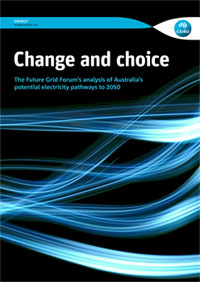| Dec 05, 2013 | |
It's electricity, but not as we know it |
|
| (Nanowerk News) A new report from the Future Grid Forum, "Change and choice: The Future Grid Forum’s analysis of Australia’s potential electricity pathways to 2050", looks at a range of opportunities and presents four scenarios, not predictions, through which we can view potential futures for our national electricity system. | |
 CSIRO Energy Flagship Chief Economist, Paul Graham, said recent declining demand, higher electricity prices and strong adoption of roof-top solar panels have changed the industry’s view of what is plausible in the future and trained a focus on affordability challenges. "All of the choices in the Future Grid Forum scenarios have consequences for the price of electricity, something that has significantly impacted consumers in recent years," Mr Graham said. "Electricity will not get cheaper in the coming decades, but bills can be reduced through the adoption of energy efficiency, peak demand management and on-site generation. "These steps, in combination with general wages growth, means the share of income average households spend on electricity is projected to be similar - shifting marginally from 2.5 per cent in 2013 to between 2.3 and 2.9 per cent in 2050 depending on the scenario.” Electricity has traditionally been a service with which consumers have not proactively engaged, but the Forum’s scenarios present a number of ways for people to take greater control of how they consume and produce electricity. "This proactive shift could potentially influence the business model for the electricity sector, encouraging the emergence of new services to supply an individually tailored product – not dissimilar to the telecommunications industry shift from a one-size-fits-all landline telephone system to a wide variety of mobile and associated data and entertainment services," Mr Graham said. |
|
| "One of the Forum's scenarios looks at the option for around a third of consumers to disconnect from the electricity grid through the use of on-site generation using technologies like rooftop solar panels and battery storage; and this is projected to be economically viable from around 2030 to 2040. | |
| "Under the full range of scenarios Australia could see on-site generation grow from the current figure of 8 per cent to reach between 18 and 45 per cent of total generation by 2050, but mostly while staying connected and using the grid as an electricity trading platform," Mr Graham said. | |
| The Forum also projected that technology will allow more sophisticated ways of managing household demand during peak times through the introduction of devices such as smart air conditioners and in-home storage systems. | |
| "Better strategies for peak demand management could save two cents per kilowatt hour or $1.4 billion per annum on distribution costs for households," Mr Graham said. | |
| The Forum findings are a starting point from which all stakeholders can begin to understand, manage and benefit from changes to the electricity system. | |
| "This is an extraordinary time of change for Australia's electricity industry and the Forum partners see the release of this report as an opportunity to begin a national conversation to decide the right answers for the sector, its stakeholders and, most importantly, all Australians," Mr Graham said. |
| Source: CSIRO |

